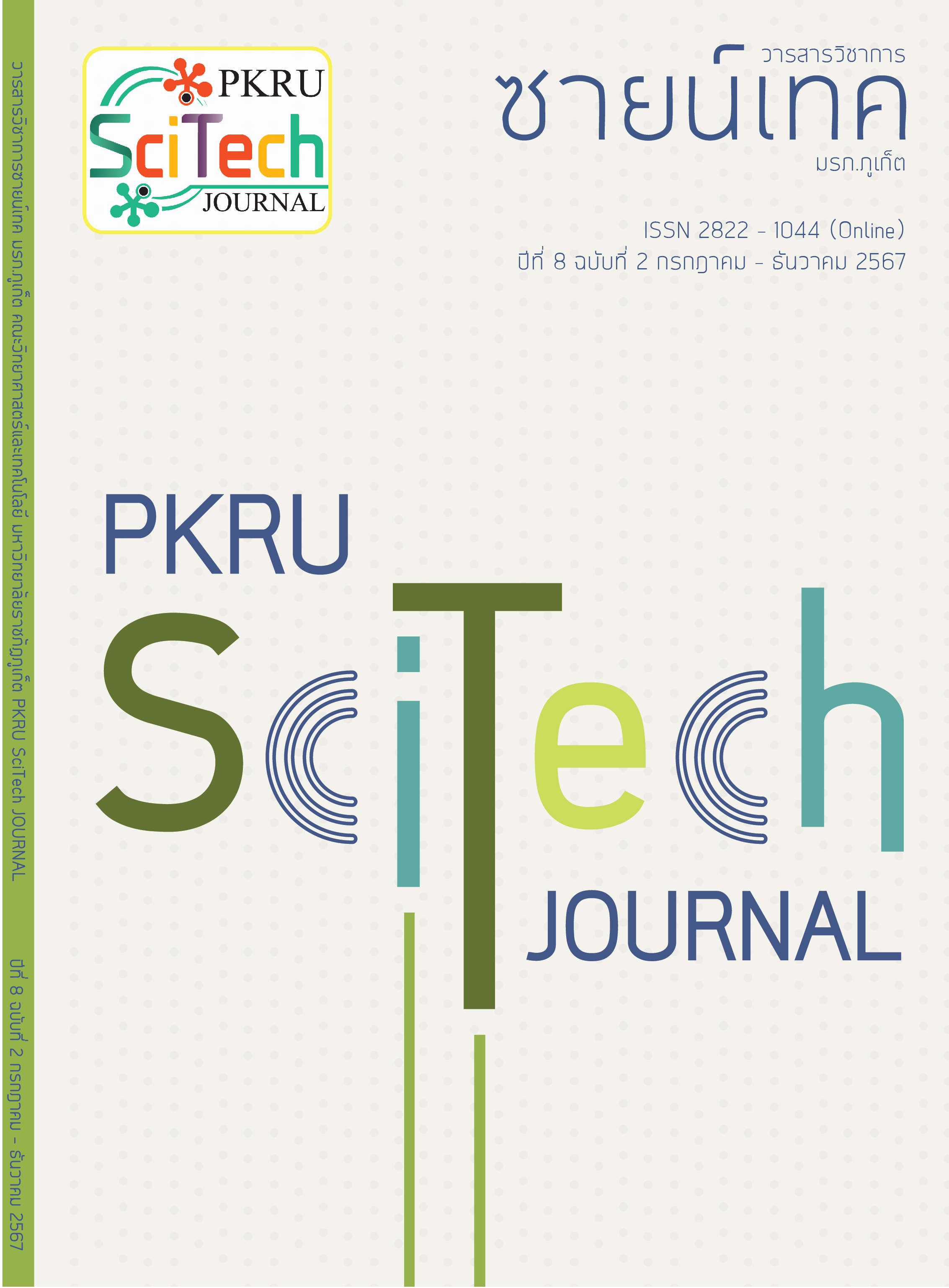การเปลี่ยนแปลงคาบการโคจรและวิวัฒนาการของระบบดาวคู่ วี 1851 โอไรโอนิดส์
Main Article Content
บทคัดย่อ
งานวิจัยนี้มีวัตถุประสงค์เพื่อศึกษาการเปลี่ยนแปลงคาบการโคจรของระบบดาวคู่ วี 1851
โอไรโอนิดส์ โดยเก็บรวบรวมข้อมูลในช่วงแสงที่ตามองเห็นด้วยกล้องดีเอสแอลอาร์ ที่ต่อเข้ากับกล้องโทรทรรศน์สะท้อนแสงขนาดเส้นผ่านศูนย์กลาง 0.2 เมตร วัดแสงด้วยเทคนิคโฟโตเมตรี
เพื่อสร้างกราฟแสงและค่าเวลาที่แสงน้อยที่สุดในช่วงอุปราคาปฐมภูมิ ผลการวิเคราะห์แสดงให้เห็นว่าระบบดาวคู่ วี 1851 โอไรโอนิดส์ มีคาบการโคจรเท่ากับ 0.2702 (±0.0028) วัน เมื่อนำข้อมูลมาเขียนเป็นแผนภาพ O – C พบว่าคาบการโคจรมีค่าลดลงในอัตรา 1.2340 ´10-11 (±0.0001´10-11)
วันต่อรอบหรือ 1.4062´10-3 (±0.0001´10-3) วินาทีต่อปี เนื่องจากการถ่ายเทพลังงานระหว่างดาวในระบบดาวคู่แบบใกล้ชิด
Article Details

อนุญาตภายใต้เงื่อนไข Creative Commons Attribution-NonCommercial-NoDerivatives 4.0 International License.
- เนื้อหาต้นฉบับที่ปรากฏในวารสารเป็นความรับผิดชอบของผู้เขียน ทั้งนี้ไม่รวมความผิดพลาดอันเกิดจากเทคนิคการพิมพ์
- ลิขสิทธิ์ต้นฉบับที่ได้รับการตีพิมพ์ในวารสารวิชาการ ซายน์เทค มรภ.ภูเก็ต ถือเป็นกรรมสิทธิ์ของวารสารวิชาการ ซายน์เทค มรภ.ภูเก็ต
เอกสารอ้างอิง
เชิดตระกูล หอมจำปา. (2552). โครงสร้างทางกายภาพของระบบดาวคู่แบบใกล้ชิด. รายงานวิจัย. มหาวิทยาลัยราชภัฏยะลา.
บุญรักษา สุนทรธรรม. (2550). ดาราศาสตร์ฟิสิกส์. สถาบันวิจัยดาราศาสตร์แห่งชาติ กระทรวงวิทยาศาสตร์และเทคโนโลยี.
บุญรักษา สุนทรธรรม. (2546). การวิเคราะห์คุณสมบัติทางกายภาพและวิวัฒนาการของระบบดาวคู่แบบเกือบแตะกันบางระบบ. รายงานวิจัย. สำนักงานคณะกรรมการวิจัยแห่งชาติ.
Essam, A., Nakhlawy. A., & Rassem, M. A. (2013). The first photometric analyses and classification of the W-UMa eclipsing binary systems GSC 1283-53 and GSC 702-1892. NRIAG Journal of Astronomy and Geophysics, 2(1), 1–7.
Blattler, E., & Diethelm, R. (2007). Observations of variables. Information Bulletin on Variable Stars, 5799, 1 – 4.
Lasker, B. M., Sturch, C. R., McLean, B. J., Russell, J. L., Jenkner, H., & Shara, M. M. (1990). The Guide Star Catalog. I - Astronomical foundations and image processing. Astronomy Journal, 99, 2019–2058.
Lohr, M. E., Norton, A. J., Payne, S. G., & West, R. G. (2015). Orbital period changes and the higher-order multiplicity fraction amongst SuperWASP eclipsing binaries. Astronomy & Astrophysics, 7, 1–7.
American Association of Variable Star Observers. (2023). AAVSO DSLR Observing Manual. [ออนไลน์], สืบค้นจาก. https://www.aavso.org/sites/default/files/
AAVSO_DSLR_Observing_Manual_v1-2 (10 มกราคม 2567).
Park, W., Pak, S., Shim, H., Le, H. A. N., Im, M., Chang, S., & Yu, J. (2015). Photometry Transformation from RGB Bayer Filter System to Johnson-Cousins BVR Filter System. Advances in Space Research, 57(1), 509–518.
Université de Strasbourg. (2023). SIMBAD Astronomical Database - CDS (Strasbourg). [ออนไลน์], สืบค้นจาก http://simbad.u-strasbg.fr/simbad (15 มกราคม 2567).
ฟ้ารุ่ง สุรินา บุญทิศ. (2565). ฟิสิกส์ดาราศาสตร์เบื้องต้นของโนวา (พิมพ์ครั้งที่ 2). เชียงราย: คณะวิทยาศาสตร์และเทคโนโลยี มหาวิทยาลัยราชภัฏเชียงราย.
Karen, A. C., John, F. K., & Keivan, G. S. (2017). Astroimagej: Image Processing and Photometric Extraction for Ultra-Precise Astronomical Light Curves. Astrophysical Journal, 115, 2.
ChangQing, L., XiaoBin, Z., Licai, D., Kun, W., Yangping, L., & Xiangsong, F. (2017). Photometric investigation of two contact binaries in the young open cluster NGC 957. New Astronomy, 52, 29–34.
Zasche, P., Liakos, A., Niarchos, P., Wolf, M., Manimanis, V., & Gazeas, K. (2008). Period changes in six contact binaries: WZ And, V803 Aql, DF Hya, PY Lyr, FZ Ori, and AH Tau. New Astronomy, 14(2), 121–128.
American Association of Variable Star Observers. (2023). Bob Nelson’s Database of Eclipsing Binary O - C. [ออนไลน์], สืบค้นจาก https://www.aavso.org/bob-nelsons-o-c-files (9 มกราคม 2567).
Pancharoen, W., & Maithong, W. (2021). The first study of a period change of the V1851 Orion binary system. ASEAN Journal of Scientific and Technological Reports, 24(3), 9–14.


